
Buenos Aires, officially the Autonomous City of Buenos Aires, is the capital and primate city of Argentina. The city is located on the western shore of the Río de la Plata, on South America's southeastern coast. "Buenos Aires" is Spanish for "fair winds" or "good airs". Buenos Aires is classified as an Alpha global city, according to the Globalization and World Cities Research Network (GaWC) 2020 ranking.

La Plata is a partido in Buenos Aires Province, Argentina, some 60 kilometres (37 mi) southeast of the city of Buenos Aires.

Belgrano is a northern and leafy barrio or neighborhood of Buenos Aires, Argentina.

Palermo is a barrio or neighborhood of Buenos Aires, Argentina. It is located in the north of the city, near the Rio de la Plata.

Villa miseria, villa de emergencia or just villa, is the informal term used in Argentina for shanty towns.
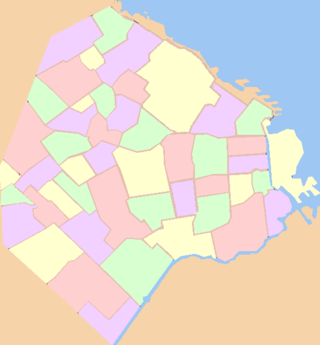
Buenos Aires, autonomous city and capital of Argentina, is composed of forty-eight neighborhoods. Since 2008, the city is also legally divided into communes, each one including one or more barrios. Among the most visited and populated barrios are Palermo, Recoleta, Puerto Madero, Belgrano, San Telmo, La Boca, Monserrat and Caballito. Sectors of the city are also traditionally known as neighborhoods by the inhabitants of Buenos Aires, but not officially by the authorities of the city; some examples include Chinatown, Barrio Norte and the Microcentro.

Puerto Madero, also known within the urban planning community as the Puerto Madero Waterfront, is a barrio of Buenos Aires in the Central Business District. Occupying a significant portion of the Río de la Plata riverbank, it is the site for several high-rise buildings and luxurious hotels, featuring the latest architectural trends.

Retiro is a barrio or neighborhood in Buenos Aires, Argentina. Located in the northeast end of the city, Retiro is bordered on the south by the Puerto Madero and San Nicolás, and on the west by the Recoleta.

Republican Proposal is a centre-right to right political party in Argentina. It is usually referred to by its abbreviation, PRO. PRO was formed as an electoral alliance in 2005, but was transformed into a national party in 2010. It is the major component of the Juntos por el Cambio coalition, and its leader is former Argentine president Mauricio Macri.
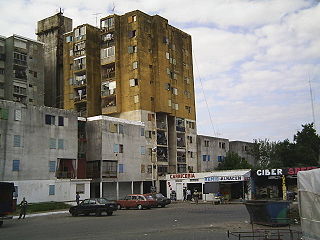
Barrio Ejército de los Andes, better known as Fuerte Apache, is a neighbourhood of Ciudadela near the city of Buenos Aires, Argentina. It is known for its high crime rates and prevalent drug use.

The Tranvía del Este, also known as the Puerto Madero Tramway, was a 12-block "demonstration" light rail line in the Puerto Madero neighborhood of Buenos Aires, Argentina, in operation from 2007 to 2012. It used French-built Alstom Citadis 302 trams on loan, initially from Mulhouse, France, and later from Madrid, Spain, and was jointly operated by Alstom, Metrovías, and Ferrovías.

Carlos Mugica was an Argentine Roman Catholic priest and activist.
Swiss Argentines are Argentine citizens of Swiss ancestry or people who emigrated from Switzerland and reside in Argentina. The Swiss Argentine community is the largest group of the Swiss diaspora in South America.

Horacio Rodríguez Larreta is an Argentine economist, politician and the former Chief of Government of the City of Buenos Aires. Larreta was re-elected in 2019 with almost 56% of the votes, becoming the first candidate to win a mayoral election in the first round since the adoption of Buenos Aires's autonomous constitution. He won in every comuna, except Comuna 4 and Comuna 8.
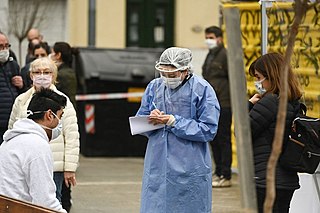
The COVID-19 pandemic in Argentina is part of the worldwide pandemic of coronavirus disease 2019 caused by severe acute respiratory syndrome coronavirus 2. As of 18 January 2024, a total of 10,076,142 people were confirmed to have been infected, and 130,693 people were known to have died because of the virus.

Paseo del Bajo - officially named Brigadier General Juan Manuel de Rosas, is a highway in the city of Buenos Aires, Argentina. It joins the 25 de Mayo, Arturo Illia and Buenos Aires-La Plata highways. It has a length of 7.1 km (4 mi) with two lanes on each direction.

Guadalupe Tagliaferri is an Argentine politician, currently serving as a National Senator for the Autonomous City of Buenos Aires since 2019. She previously served as Minister of Human Development of Buenos Aires in the administration of Chief of Government Horacio Rodríguez Larreta from 2015 to 2019. She belongs to the Republican Proposal (PRO) party.
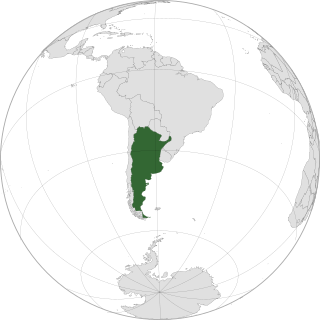
Squatting in Argentina is the occupation of derelict buildings or unused land without the permission of the owner. Shanty towns emerged on the periphery of Buenos Aires from the 1930s onwards and are known as villa miseria. After the 1998–2002 Argentine great depression, 311 worker cooperatives set up across the country as people squatted and re-opened businesses.
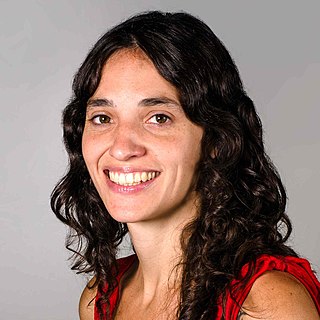
Paula Andrea Penacca is an Argentine politician and social activist, who is currently a member of the Argentine Chamber of Deputies elected in the Autonomous City of Buenos Aires since 2019 for the Frente de Todos coalition. A member of the Justicialist Party and La Cámpora, Penacca previously served as a member of the Buenos Aires City Legislature from 2013 to 2019.
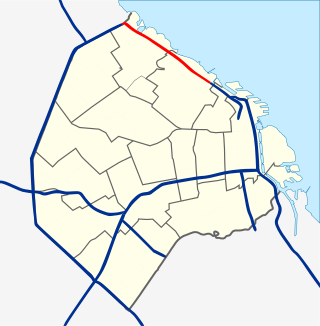
Avenida Leopoldo Lugones, and its southern continuation, Autopista Dr. Arturo Umberto Illia, is a freeway running from Avenida General Paz in the north, which continues to an interchange with National Route 9 and the Paseo del Bajo in the city center. It provides access to Downtown Buenos Aires from the northern suburbs, and from Rosario, Cordoba, and other northern destinations. Due to the lack of a complete bypass of the city, it also connects truck and bus traffic from La Plata to the north. It runs along the east shore of the city, providing access to Aeroparque Jorge Newbery.




















